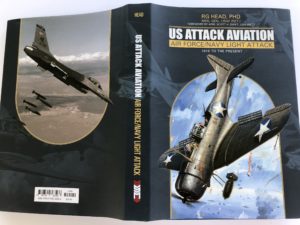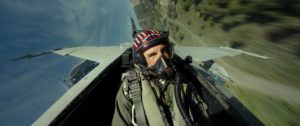Blown Slick Series# 14
“… it has been decades since the last significant contribution to airpower theory. Given the shifting character of war and rapid technological change, a solid modern airpower theory will be required for the West to achieve strategic success in future conflicts.” Reviewing Airpower Reborn;The Strategic Concepts of John Warden and John Boyd by JP ‘Spear’ Mintz
This is an update on the series begun in early 2015 Blown Slick; Light Attack Fast Pursuit Airpower Analysis by Boris.
Since January 2020 I have been primarily focused (and leveraging RememberedSky  posts) on supporting my long time friend RG Head (PhD, Brigadier General USAF, Ret) on his just released book US Attack Aviation – Air Force/Navy Light Attack/1916 to Present.
posts) on supporting my long time friend RG Head (PhD, Brigadier General USAF, Ret) on his just released book US Attack Aviation – Air Force/Navy Light Attack/1916 to Present.
The following is an update on the series and precursor to a book review which will follow shortly.
Remembered Sky began in the fall of 2012 as a way to tell the stories of myself and my friends from that ’72-’73 Vietnam war cruise (the Operation Linebacker I & II periods) on USS Midway in my first squadron, VA-56. A significant catalyst was my decision to reread many of the books and articles I had collected over the years related to air combat and particularly Naval Aviation given its 100th year anniversary.
Those books and articles included the evolution of carrier warfare and the 1930’s Fleet Battle Problems and my continuing fascination with the complete history of the 1942 Battle of Midway. Key operational threads and several distinctly focused series have been used to tell the stories: 1) Air War Vietnam 1972; 2) the overall aircraft carrier environment (to include significant naval aviation history; 3) the near disaster on Midway’s flight deck on the night of 24 Oct, 1972; 4) the ’72 Christmas time frame; and finally 5) Operation Homecoming and the return home of our POW’s.
That effort went on for three years or so and I have added a few “coming home” stories later. The site has been much fun to do and allowed me to connect with some really great folks. The FaceBook side has grown to 2000+ followers and my distro is a little under 500.
Tying 1) the history; 2) the re-treading of my own years within that story; and 3) the emergent anti-access/area denial threat particularly in the South China Sea, and the on going issues with the F-35 and the apparent end to the A-10, presented the basis for a next series for the site. This then is the background for discussion of the evolution of fighter, attack, and strike warfare – Blown Slick – the series.
The term “blown slick” was coined within the ready-room fly-boy give and take of my VA-56 Champs squadron in regard to, shall we say, battle damage assessment of our attack missions into North Vietnam and the “even-the strain” battles of Hong Kong, Singapore, and the Cubi Point Officers Club at Subic Bay, Philippines 😉
The working hypothesis was/is that the combination of world problems/threat environments combined with emerging technology and tactical application with implied changes, suggest that the application of U.S. airpower could be at a watershed moment. Decisions are pending or may already have been made that could leave all services airpower capabilities weaker rather than better able to serve our defense needs. Either way, I thought it deserved some discussion. One subset of the effort was a deep look at carrier aviation in 1942 and investigation of possible similarities with the “island chain” context of the Japanese and the current Chinese South China Sea endeavors.
The telling of 40+ year old war stories has served as a stake in the ground, and a catalyst to tease out through a mosaic of articles on airpower subjects what the future might hold given the nature of today’s emerging warfare environment: 1) War at Sea in an Anti-Access/Area Denial scenario with high threat capability such as that of China; along with 2) the seeming persistence of the insurgent-type battlefield with both strike and CAS requirements; and the growing dark cloud of 3) possible conventional air/land war in Ukraine.
That said and having completed the subset series 1942-The Year of the Carrier, ten years in I’m still intrigued by several issues related to tactical airpower application:
- Linebacker at 50 years (several new books and perspectives for review)
- Airpower future through the lens of Close Air Support
- Tactical a/c design process/programs/technology as it has evolved from A-4s as a nuke delivery platform up to the current “strike fighter” including context and terminology of multi-role vs specialized aircraft and the “fighter” vs “attack” dynamic
As noted, the last two years have been leveraging the work to assist to RG Head on his just released book: US Attack Aviation – Air Force/Navy Light Attack/1916 to Present. RG Head has woven together a rich history of air warfare that tells an intriguing and I dare say, educational story that includes aspects little known or appreciated, even unknown history to many. There are key elements related to the Army and Close Air Support, Air force drive to be an independent service leveraging the strategic bomber, Navy and Marine culture driven by war at and from the sea, and differences in the way the business of warfare, its technology, people have evolved; I.e., the evolution and continuation of multiple air combat cultures.
RG’s book can be viewed as an historical backwards and forward look at the business of fast mover attack with the A-7D/E as a mid point stake in the ground. Based on his PhD thesis on the A-7 upgrade process that brought the AF in as a player, he is uniquely qualified….and he’s as close to a Navy Attack guy as you can get being a light blue suiter. He flew the F-100, A-1 with 325 missions in VN, and the F-4 as instructor and squadron commander.
Final note:
After Vietnam, the Air Force had to take seriously training for non-Nuclear-centric war. This resulted in the Red Flag training events. After Desert Storm, the Navy had to recognize the transition from concern with the Soviet Navy and then move into the joint campaign context. Post 9-11 warfare in Iraq and Afghanistan, both services have had to come to grip with “war amongst the people.” For the future – more of the same AND recognition that CAS is singularly important AND concurrently, preparation for conflict in an anti-access area denial (A2/AD) threat environment that could occur in the South China Sea – return to war-at-sea – is most definitely a joint thing.
And so …“Blown Slick Light Attack Fast Pursuit Airpower Analysis by Boris”
Taking a shot at what being an attack pilot, fighter pilot, strike fighter pilot, or whatever you call them in this future, will be about – some ventured thought.
The series has begun for your amusement and reflection. As always critique and comments always welcome.
Please note: The big mission for TOPGUN – Maverick is what ATTACK PILOTS do. The aircraft used is the F/A-18 Hornet – Fighter/Attack strike fighter. Just saying;)
To Be Continued







